Top five signs that termites might be eating your home
With spring on the horizon, subterranean termites, the most destructive termite species, will begin swarming. The bad news: they may be seeking out your home for their new nesting space.
As pest management professionals across the country recognize Termite Awareness Week March 8-12, Clark, your neighborly pest control, lawn care, and termite expert, would like to share the top five signs that a home may be infested with destructive termites.
It’s estimated that termites cause $5 billion in damage to homes every year. For you, that might mean costly repair bills if you don’t spot and control a termite infestation sooner rather than later. To add insult to injury, the damage caused by termites is typically not covered by homeowner insurance.
Subterranean termites do the majority of their destructive handiwork out of sight – below ground, in attics, wall voids, and crawlspaces. Because most homeowners don’t recognize the more visible signs of an infestation, corrective actions are usually delayed until it is too late.
Now, Clark doesn’t recommend that you perform your own termite inspection. However, there are a few red flags you can look for that may signal the presence of an infestation. Here are five signs that your home may have termites:
- Swarmers or their discarded wings: Swarmers, also known as alates or reproductives, are young female and male winged termites. In spring, after the last freeze, termite swarmers will emerge from the nest to mate and search for a new location to start a colony, which may include your home. Termite swarmers, or their discarded wings near windowsills and doors, are often the first and only visible sign of a termite problem.
- Mud tubes: Subterranean termites build mud tubes to provide moisture while they travel between their colony and food source. Mud tubes are most often found near a home’s foundation. They look like encrusted, dry dirt – around the circumference of a drinking straw.
- Wood damage: Termites tend to eat wood from the inside out. Wood that sounds hollow when tapped often signifies a termite infestation. Additionally, you also should look for blistered pieces of wood.
- Uneven or bubbling paint: Uneven or bubbling paint is often a sign of moisture buildup, which could mean one of two things – water damage or termites.
- Frass: Drywood termites produce wood-colored droppings as they eat through infested wood. If you find a small pile of what looks like grains of sand or coffee grounds inside or outside your home, it could be a sign of a drywood termite infestation.
You can protect your home from subterranean termites this spring. Call or text (800) WE-NEED-YOU (936-3339) or email the Clark termite experts at clarkcares@clarkpest.com to schedule a professional inspection of your home. If termites are present, your Clark termite inspector will review treatment options available to you.
And don’t forget to ask about Clark’s exclusive Termite Infestation Protection (TIP) program, which will cover your home against future infestations and damages. A full termite inspection must be performed to see if your home qualifies, and then, for a small monthly fee, you can avoid costly out-of-pocket treatment and repair expenses. This will save you money and headaches and give you peace of mind.
Until next time, thank you for helping to keep unwanted pests and termites out of your home and yard.


